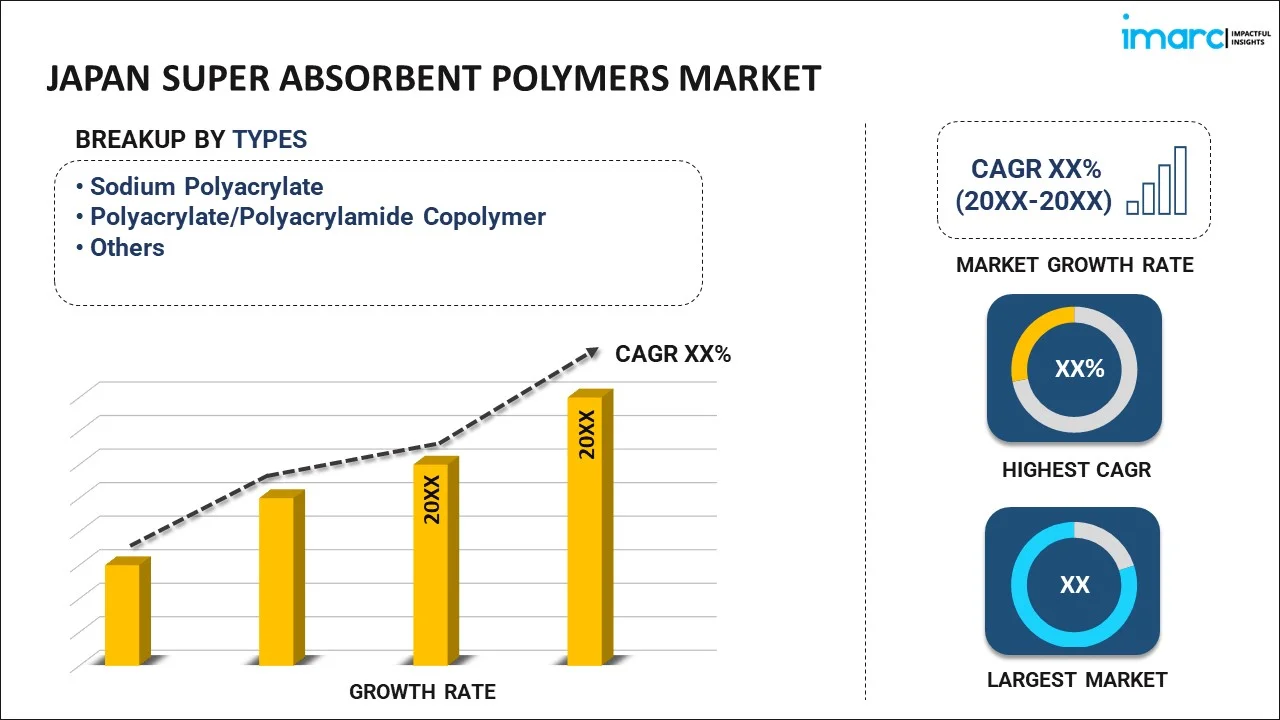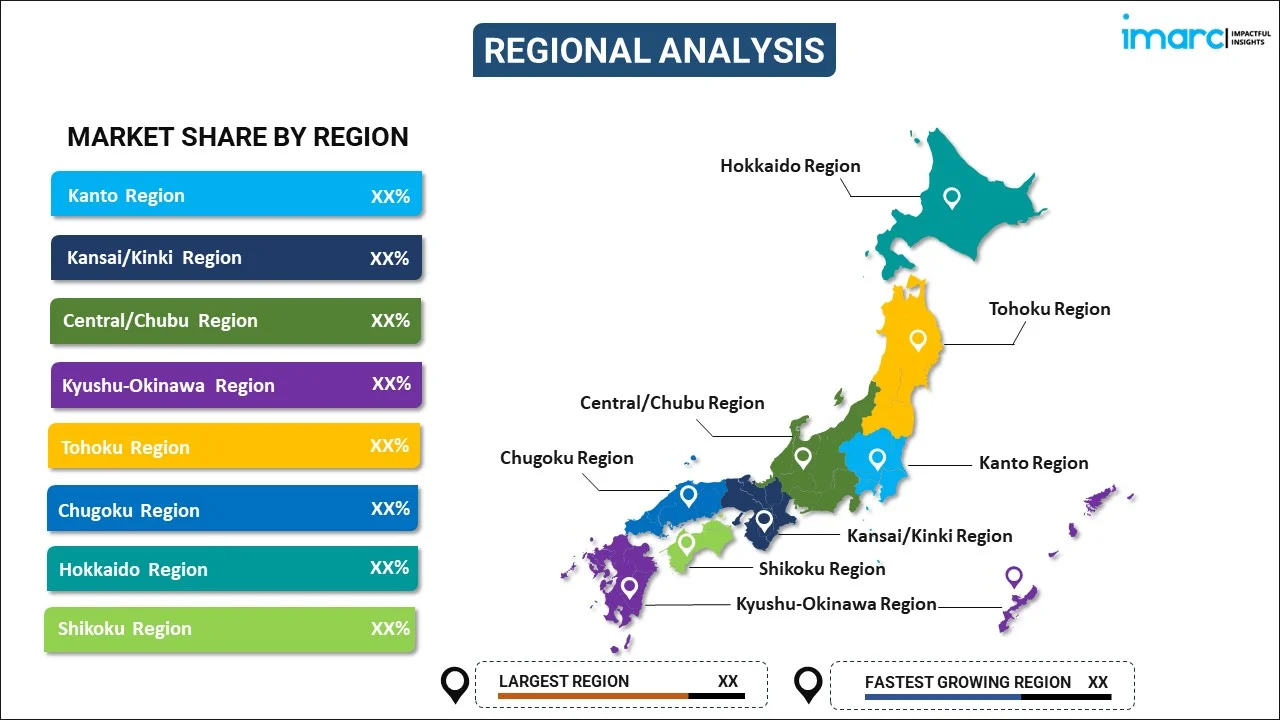
Japan Super Absorbent Polymers Market Report by Type (Sodium Polyacrylate, Polyacrylate/Polyacrylamide Copolymer, and Others), Production Method (Suspension Polymerization, Solution Polymerization, Gel Polymerization), Application (Personal Hygiene, Agriculture, Medical, Industrial, and Others), and Region 2025-2033
Market Overview:
Japan super absorbent polymers market size reached USD 632.5 Million in 2024. Looking forward, IMARC Group expects the market to reach USD 1,041.7 Million by 2033, exhibiting a growth rate (CAGR) of 5.2% during 2025-2033. The widespread adoption of sustainable materials and practices in the construction industry, along with the inflating need for materials to protect against skin irritation, is primarily driving the market growth.
|
Report Attribute
|
Key Statistics
|
|---|---|
|
Base Year
|
2024 |
|
Forecast Years
|
2025-2033
|
|
Historical Years
|
2019-2024
|
| Market Size in 2024 | USD 632.5 Million |
| Market Forecast in 2033 | USD 1,041.7 Million |
| Market Growth Rate (2025-2033) | 5.2% |
Super absorbent polymers (SAPs) are materials with the capacity to retain significant amounts of liquid. They are derived from cross-linked polymer networks of acrylic acid, comprising water-soluble building blocks. These substances are hygroscopic, resembling white sugar, and have the ability to absorb water, transforming into transparent gel-like particles that can maintain moisture even under pressure without breaking or leaking. SAPs are widely employed as absorbents for water and aqueous solutions in products such as diapers, adult incontinence items, and feminine hygiene products. Their primary function is to keep the skin dry, thus safeguarding against skin irritation, reducing the risk of infections, and enhancing the overall quality of life and personal comfort. Consequently, they have extensive applications not only in these hygiene-related fields but also in sectors like automotive, construction, and packaging due to their exceptional liquid-absorbing properties.
Japan Super Absorbent Polymers Market Trends:
The Japan market for super absorbent polymers is experiencing significant growth due to several key factors. Firstly, there is a rising demand for high-quality diapers, driven by increasing parental concerns regarding the health and hygiene of their infants. This heightened awareness is boosting the need for SAPs in the country. Secondly, there is a growing awareness among women in Japan concerning personal hygiene, leading to increased sales of sanitary napkins. This trend is contributing to the expansion of the super absorbent polymers market in the feminine hygiene sector. Moreover, the agricultural sector in Japan is witnessing an uptick in farming activities, resulting in an increased demand for SAPs. These polymers play a crucial role in reducing soil erosion from surface run-offs and preventing the leaching of fertilizers and pesticides into groundwater. Furthermore, super absorbent polymers are being utilized for the safe management of infected respiratory secretions, particularly given the increasing prevalence of viral infections. This application is further driving market growth. Lastly, the market is benefiting from extensive research and development efforts by leading industry players focused on developing bio-based SAPs. This innovation is expected to have a positive impact on the super absorbent polymers market in Japan over the forecasted period.
Japan Super Absorbent Polymers Market Segmentation:
IMARC Group provides an analysis of the key trends in each segment of the market, along with forecasts at the country level for 2025-2033. Our report has categorized the market based on type, production method, and application.
Type Insights:

- Sodium Polyacrylate
- Polyacrylate/Polyacrylamide Copolymer
- Others
The report has provided a detailed breakup and analysis of the market based on the type. This includes sodium polyacrylate, polyacrylate/polyacrylamide copolymer, and others.
Production Method Insights:
- Suspension Polymerization
- Solution Polymerization
- Gel Polymerization
A detailed breakup and analysis of the market based on the production method have also been provided in the report. This includes suspension polymerization, solution polymerization, and gel polymerization.
Application Insights:
- Personal Hygiene
- Agriculture
- Medical
- Industrial
- Others
The report has provided a detailed breakup and analysis of the market based on the application. This includes personal hygiene, agriculture, medical, industrial, and others.
Regional Insights:

- Kanto Region
- Kansai/Kinki Region
- Central/ Chubu Region
- Kyushu-Okinawa Region
- Tohoku Region
- Chugoku Region
- Hokkaido Region
- Shikoku Region
The report has also provided a comprehensive analysis of all the major regional markets, which include Kanto Region, Kansai/Kinki Region, Central/ Chubu Region, Kyushu-Okinawa Region, Tohoku Region, Chugoku Region, Hokkaido Region, and Shikoku Region.
Competitive Landscape:
The market research report has also provided a comprehensive analysis of the competitive landscape in the market. Competitive analysis such as market structure, key player positioning, top winning strategies, competitive dashboard, and company evaluation quadrant has been covered in the report. Also, detailed profiles of all major companies have been provided.
Japan Super Absorbent Polymers Market Report Coverage:
| Report Features | Details |
|---|---|
| Base Year of the Analysis | 2024 |
| Historical Period | 2019-2024 |
| Forecast Period | 2025-2033 |
| Units | Million USD |
| Scope of the Report | Exploration of Historical Trends and Market Outlook, Industry Catalysts and Challenges, Segment-Wise Historical and Future Market Assessment:
|
| Types Covered | Sodium Polyacrylate, Polyacrylate/Polyacrylamide Copolymer, Others |
| Production Methods Covered | Suspension Polymerization, Solution Polymerization, Gel Polymerization |
| Applications Covered | Personal Hygiene, Agriculture, Medical, Industrial, Others |
| Regions Covered | Kanto Region, Kansai/Kinki Region, Central/ Chubu Region, Kyushu-Okinawa Region, Tohoku Region, Chugoku Region, Hokkaido Region, Shikoku Region |
| Customization Scope | 10% Free Customization |
| Post-Sale Analyst Support | 10-12 Weeks |
| Delivery Format | PDF and Excel through Email (We can also provide the editable version of the report in PPT/Word format on special request) |
Key Questions Answered in This Report:
- How has the Japan super absorbent polymers market performed so far and how will it perform in the coming years?
- What has been the impact of COVID-19 on the Japan super absorbent polymers market?
- What is the breakup of the Japan super absorbent polymers market on the basis of type?
- What is the breakup of the Japan super absorbent polymers market on the basis of production method?
- What is the breakup of the Japan super absorbent polymers market on the basis of application?
- What are the various stages in the value chain of the Japan super absorbent polymers market?
- What are the key driving factors and challenges in the Japan super absorbent polymers?
- What is the structure of the Japan super absorbent polymers market and who are the key players?
- What is the degree of competition in the Japan super absorbent polymers market?
Key Benefits for Stakeholders:
- IMARC’s industry report offers a comprehensive quantitative analysis of various market segments, historical and current market trends, market forecasts, and dynamics of the Japan super absorbent polymers market from 2019-2033.
- The research report provides the latest information on the market drivers, challenges, and opportunities in the Japan super absorbent polymers market.
- Porter's five forces analysis assist stakeholders in assessing the impact of new entrants, competitive rivalry, supplier power, buyer power, and the threat of substitution. It helps stakeholders to analyze the level of competition within the Japan super absorbent polymers industry and its attractiveness.
- Competitive landscape allows stakeholders to understand their competitive environment and provides an insight into the current positions of key players in the market.
Need more help?
- Speak to our experienced analysts for insights on the current market scenarios.
- Include additional segments and countries to customize the report as per your requirement.
- Gain an unparalleled competitive advantage in your domain by understanding how to utilize the report and positively impacting your operations and revenue.
- For further assistance, please connect with our analysts.
 Inquire Before Buying
Inquire Before Buying
 Speak to an Analyst
Speak to an Analyst
 Request Brochure
Request Brochure
 Request Customization
Request Customization




.webp)




.webp)












